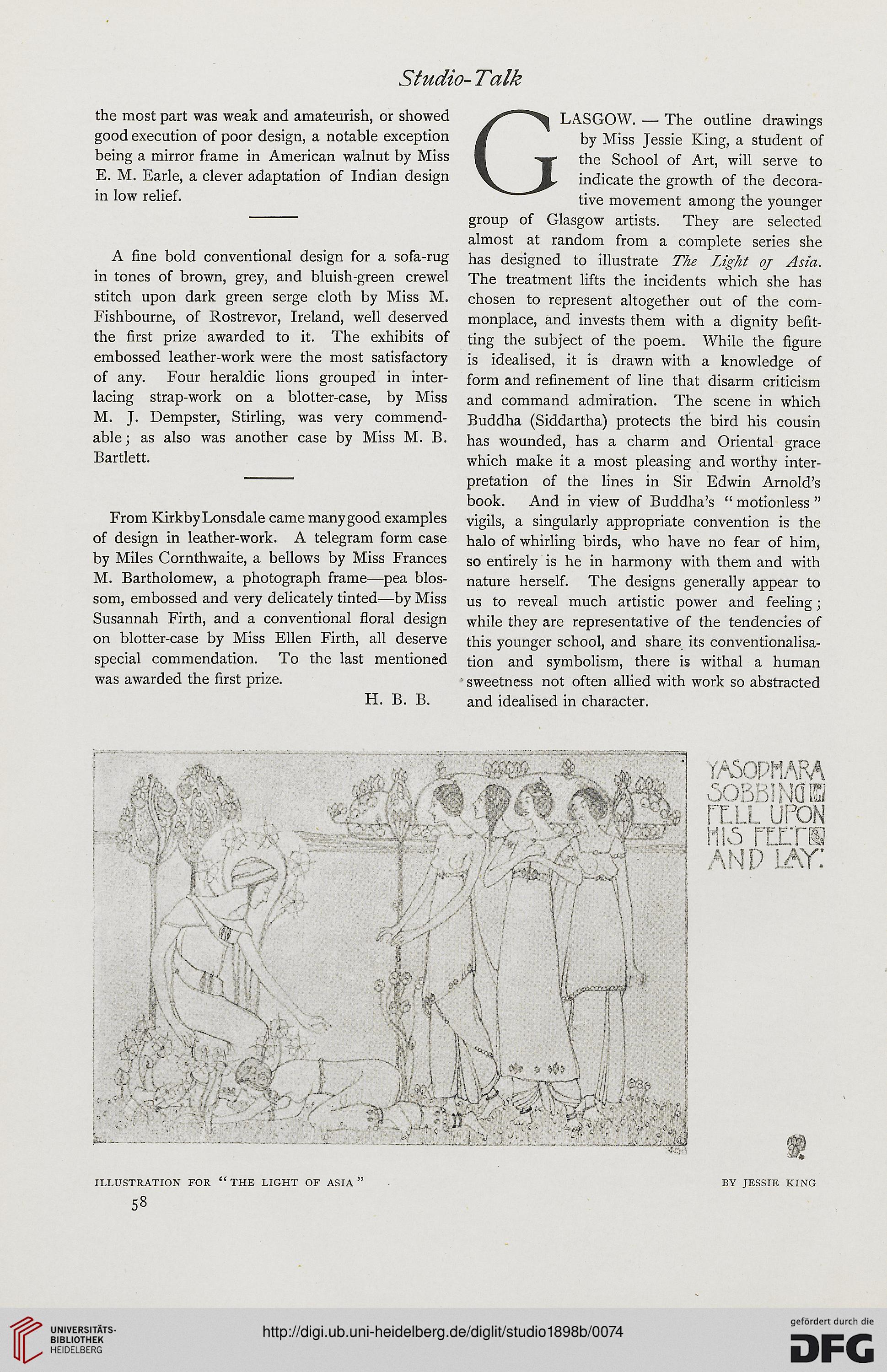Studio-Talk
the most part was weak and amateurish, or showed
good execution of poor design, a notable exception
being a mirror frame in American walnut by Miss
E. M. Earle, a clever adaptation of Indian design
in low relief.
A fine bold conventional design for a sofa-rug
in tones of brown, grey, and bluish-green crewel
stitch upon dark green serge cloth by Miss M.
Fishbourne, of Rostrevor, Ireland, well deserved
the first prize awarded to it. The exhibits of
embossed leather-work were the most satisfactory
of any. Four heraldic lions grouped in inter-
lacing strap-work on a blotter-case, by Miss
M. J. Dempster, Stirling, was very commend-
able; as also was another case by Miss M. B.
Bartlett.
From Kirkby Lonsdale came many good examples
of design in leather-work. A telegram form case
by Miles Cornthwaite, a bellows by Miss Frances
M. Bartholomew, a photograph frame—pea blos-
som, embossed and very delicately tinted—by Miss
Susannah Firth, and a conventional floral design
on blotter-case by Miss Ellen Firth, all deserve
special commendation. To the last mentioned
was awarded the first prize.
H. B. B.
GLASGOW. — The outline drawings
by Miss Jessie King, a student of
the School of Art, will serve to
indicate the growth of the decora-
tive movement among the younger
group of Glasgow artists. They are selected
almost at random from a complete series she
has designed to illustrate The Light oj Asia.
The treatment lifts the incidents which she has
chosen to represent altogether out of the com-
monplace, and invests them with a dignity befit-
ting the subject of the poem. While the figure
is idealised, it is drawn with a knowledge of
form and refinement of line that disarm criticism
and command admiration. The scene in which
Buddha (Siddartha) protects the bird his cousin
has wounded, has a charm and Oriental grace
which make it a most pleasing and worthy inter-
pretation of the lines in Sir Edwin Arnold’s
book. And in view of Buddha’s “ motionless ”
vigils, a singularly appropriate convention is the
halo of whirling birds, who have no fear of him,
so entirely is he in harmony with them and with
nature herself. The designs generally appear to
us to reveal much artistic power and feeling;
while they are representative of the tendencies of
this younger school, and share its conventionalisa-
tion and symbolism, there is withal a human
sweetness not often allied with work so abstracted
and idealised in character.
YASOPHARA
oOSBINGIS
FILL UPON
1116 FILTHS
AND lay:
ILLUSTRATION FOR “ THE LIGHT OF ASIA
58
BY JESSIE KING
the most part was weak and amateurish, or showed
good execution of poor design, a notable exception
being a mirror frame in American walnut by Miss
E. M. Earle, a clever adaptation of Indian design
in low relief.
A fine bold conventional design for a sofa-rug
in tones of brown, grey, and bluish-green crewel
stitch upon dark green serge cloth by Miss M.
Fishbourne, of Rostrevor, Ireland, well deserved
the first prize awarded to it. The exhibits of
embossed leather-work were the most satisfactory
of any. Four heraldic lions grouped in inter-
lacing strap-work on a blotter-case, by Miss
M. J. Dempster, Stirling, was very commend-
able; as also was another case by Miss M. B.
Bartlett.
From Kirkby Lonsdale came many good examples
of design in leather-work. A telegram form case
by Miles Cornthwaite, a bellows by Miss Frances
M. Bartholomew, a photograph frame—pea blos-
som, embossed and very delicately tinted—by Miss
Susannah Firth, and a conventional floral design
on blotter-case by Miss Ellen Firth, all deserve
special commendation. To the last mentioned
was awarded the first prize.
H. B. B.
GLASGOW. — The outline drawings
by Miss Jessie King, a student of
the School of Art, will serve to
indicate the growth of the decora-
tive movement among the younger
group of Glasgow artists. They are selected
almost at random from a complete series she
has designed to illustrate The Light oj Asia.
The treatment lifts the incidents which she has
chosen to represent altogether out of the com-
monplace, and invests them with a dignity befit-
ting the subject of the poem. While the figure
is idealised, it is drawn with a knowledge of
form and refinement of line that disarm criticism
and command admiration. The scene in which
Buddha (Siddartha) protects the bird his cousin
has wounded, has a charm and Oriental grace
which make it a most pleasing and worthy inter-
pretation of the lines in Sir Edwin Arnold’s
book. And in view of Buddha’s “ motionless ”
vigils, a singularly appropriate convention is the
halo of whirling birds, who have no fear of him,
so entirely is he in harmony with them and with
nature herself. The designs generally appear to
us to reveal much artistic power and feeling;
while they are representative of the tendencies of
this younger school, and share its conventionalisa-
tion and symbolism, there is withal a human
sweetness not often allied with work so abstracted
and idealised in character.
YASOPHARA
oOSBINGIS
FILL UPON
1116 FILTHS
AND lay:
ILLUSTRATION FOR “ THE LIGHT OF ASIA
58
BY JESSIE KING




